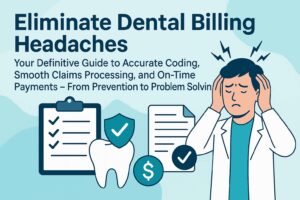
Mastering Dental Credentialing with Automation: A Comprehensive Guide to Streamlined Services

As a dental professional, you understand the importance of providing quality care to your patients. However, running a successful dental practice involves more than just clinical expertise. Managing the financial aspect of your practice is equally crucial. This is where dental billing comes into play. In this comprehensive guide, we will explore the ins and outs of dental billing, including the benefits of automated dental billing and credentialing services.
Table of Contents
Introduction to Dental Billing
- What is Dental Billing?
- The Importance of Dental Billing for Your Practice
The Challenges of Traditional Dental Billing
- Time-consuming Administrative Tasks
- Compliance and Credentialing Issues
- Financial Implications of Billing Errors
The Benefits of Automated Dental Billing
- Streamlined Workflow and Time Savings
- Enhanced Accuracy and Compliance
- Improved Revenue Cycle Management
Understanding Dental Credentialing
- What is Dental Credentialing?
- Why is Dental Credentialing Important?
- Credentialing Process and Requirements
The Advantages of Automated Dental Credentialing Services
- Time Savings and Efficiency
- Cost Reduction and Revenue Maximization
- Elimination of Administrative Headaches
Introducing One Dental Billing: Your Dental Billing Outsourcing Partner
- Why Choose One Dental Billing?
- Comprehensive Dental Billing Services
- How One Dental Billing Can Benefit Your Practice
Steps to Implement Automated Dental Billing and Credentialing Services
- Assess Your Practice’s Needs
- Research and Choose a Reliable Service Provider
- Prepare the Necessary Documentation
- Collaborate with the Service Provider for a Smooth Transition
Best Practices for Successful Dental Billing
- Ensure Accurate Documentation and Coding
- Stay Up-to-Date with Insurance Policies and Reimbursement Rates
- Regularly Monitor and Analyze Key Performance Indicators
- Continuously Educate and Train Your Team
Common Challenges in Dental Billing and How to Overcome Them
- Insurance Claim Denials and Appeals
- Patient Billing and Collections
- Communication and Collaboration with Insurance Companies
- Staying Compliant with Changing Regulations
The Future of Dental Billing: Emerging Trends and Technologies
- Artificial Intelligence and Machine Learning
- Telehealth and Virtual Consultations
- Integration of Electronic Health Records and Billing Systems
- Patient Portals and Online Payment Solutions
Frequently Asked Questions about Dental Billing and Credentialing
- How long does the dental billing process typically take?
- What are the common reasons for insurance claim denials?
- How often should dental practices update their credentials?
- Can dental billing services be customized to the needs of my practice?
Conclusion: Unlocking the Potential of Dental Billing
- The Impact of Efficient Dental Billing on Practice Success
- Embracing Automation for a Seamless Revenue Cycle
- Choosing the Right Dental Billing Solution for Your Practice
1. Introduction to Dental Billing
What is Dental Billing?
Dental billing refers to the process of submitting and managing insurance claims, tracking payments, and handling patient billing for dental services. It plays a crucial role in the financial health and success of dental practices by ensuring accurate reimbursement and streamlining the revenue cycle.
The Importance of Dental Billing for Your Practice
Effective dental billing is essential for maintaining a steady cash flow, minimizing denials and rejections, and optimizing revenue collection. It involves careful documentation, accurate coding, and adherence to insurance policies and guidelines. By managing dental billing efficiently, you can focus on providing quality care to your patients while ensuring the financial stability of your practice.
2. The Challenges of Traditional Dental Billing
Time-consuming Administrative Tasks
Traditional dental billing methods often involve manual data entry, paper-based documentation, and extensive follow-up with insurance companies. These tasks can be time-consuming and prone to errors, leading to delays in reimbursement and increased administrative burden on your team.
Compliance and Credentialing Issues
Dental practices must maintain up-to-date credentials with insurance companies to receive reimbursement for services provided to in-network patients. Credentialing can be a complex and time-consuming process, involving the verification of licenses, qualifications, and other professional information. Failure to comply with credentialing requirements can result in claim denials and financial loss.
Financial Implications of Billing Errors
Inaccurate coding, incomplete documentation, and billing errors can have a significant impact on your practice’s revenue. They can lead to claim denials, delayed payments, and even legal issues. Resolving billing errors can be time-consuming and costly, affecting both your financial stability and reputation.
3. The Benefits of Automated Dental Billing
Streamlined Workflow and Time Savings
Automated dental billing solutions leverage technology to streamline administrative tasks, such as claim submission, payment tracking, and patient billing. By automating these processes, you can reduce the time spent on manual data entry and follow-up, allowing your team to focus more on patient care.
Enhanced Accuracy and Compliance
Automated dental billing systems incorporate built-in checks and balances to ensure accurate coding, proper documentation, and adherence to insurance policies and regulations. They minimize the risk of errors and increase compliance with industry standards, reducing the likelihood of claim denials and audits.
Improved Revenue Cycle Management
Efficient dental billing systems provide real-time visibility into the revenue cycle, allowing you to track claims, monitor payment trends, and identify areas for improvement. By optimizing revenue collection and reducing payment delays, automated billing solutions can positively impact your practice’s financial performance.
4. Understanding Dental Credentialing
What is Dental Credentialing?
Dental credentialing is the process of verifying a dentist’s qualifications, licenses, and professional standing to participate in insurance networks. It involves submitting the necessary documentation and meeting the eligibility criteria set by insurance companies to become an in-network provider.
Why is Dental Credentialing Important?
Dental credentialing is essential for dentists who wish to be reimbursed by insurance companies for services provided to covered patients. It ensures that dentists meet the required standards of care, maintain valid licenses, and comply with insurance company policies. Without proper credentialing, dentists may face claim denials, delayed payments, and limited access to a larger patient pool.
Credentialing Process and Requirements
The dental credentialing process typically involves submitting applications, supporting documents, and fees to insurance companies. These documents may include proof of education, licenses, malpractice insurance, and professional references. Insurance companies review the submitted information to determine the dentist’s eligibility for participation in their networks.
5. The Advantages of Automated Dental Credentialing Services
Time Savings and Efficiency
Automated dental credentialing services eliminate the need for manual paperwork, repetitive data entry, and follow-up with insurance companies. By automating the credentialing process, you can save time and resources, allowing your dental team to focus on patient care and practice growth.
Cost Reduction and Revenue Maximization
Manual credentialing processes can be costly, requiring dedicated staff and resources to manage the paperwork and administrative tasks involved. By automating credentialing, you can reduce administrative costs, minimize credentialing-related errors, and optimize revenue collection through timely reimbursements.
Elimination of Administrative Headaches
Automated credentialing services handle the entire credentialing process, from application submission to document verification and follow-up. This eliminates the administrative burden on your team, ensuring a smooth and hassle-free experience. You can rely on the expertise of the service provider to navigate the complex credentialing requirements, ensuring compliance and avoiding claim denials.
6. Introducing One Dental Billing: Your Dental Billing Outsourcing Partner
Why Choose One Dental Billing?
At One Dental Billing, we understand the unique challenges faced by dental practices when it comes to billing and credentialing. We offer comprehensive dental billing outsourcing services tailored to your practice’s needs, allowing you to focus on patient care while we handle the financial aspects of your practice.
Comprehensive Dental Billing Services
Our dental billing services cover a wide range of tasks, including claim submission, payment posting, insurance follow-up, patient billing, and revenue analysis. We leverage advanced technology and experienced professionals to ensure accurate and efficient billing processes, maximizing your practice’s revenue potential.
How One Dental Billing Can Benefit Your Practice
By partnering with One Dental Billing, you can experience the following benefits:
- Streamlined billing processes and reduced administrative burden
- Enhanced revenue cycle management and improved cash flow
- Increased accuracy and compliance with insurance policies
- Access to real-time billing data and performance analytics
- Expert guidance and support from our dedicated team of dental billing professionals
7. Steps to Implement Automated Dental Billing and Credentialing Services
Assess Your Practice’s Needs
Before implementing automated dental billing and credentialing services, evaluate your practice’s specific requirements and goals. Consider factors such as practice size, patient volume, existing billing processes, and desired outcomes. This assessment will help you choose the most suitable service provider and tailor the implementation process accordingly.
Research and Choose a Reliable Service Provider
Thoroughly research different dental billing and credentialing service providers in the market. Look for reputable companies with a proven track record, positive client reviews, and expertise in dental billing and credentialing. Consider factors such as technology capabilities, service offerings, pricing structure, and customer support.
Prepare the Necessary Documentation
Gather all the required documentation for the credentialing process, including licenses, certifications, malpractice insurance, and professional references. Ensure that the documentation is up-to-date and meets the specific requirements of each insurance company you wish to participate in. Organize the documents in a digital format for easy submission and future reference.
Collaborate with the Service Provider for a Smooth Transition
Once you have selected a service provider, collaborate closely with their team to ensure a seamless transition to automated dental billing and credentialing. Provide them with the necessary information and access to your practice management system. Communicate your practice’s requirements and expectations clearly to ensure a customized and efficient implementation process.
8. Best Practices for Successful Dental Billing
Ensure Accurate Documentation and Coding
Accurate documentation and coding are crucial for successful dental billing. Train your team on proper documentation practices, including detailed clinical notes and accurate coding of procedures. Regularly audit your documentation to identify any areas for improvement and provide ongoing training to ensure compliance with coding guidelines.
Stay Up-to-Date with Insurance Policies and Reimbursement Rates
Insurance policies and reimbursement rates can change frequently. Stay informed about the latest updates from insurance companies, including changes in coverage, fee schedules, and documentation requirements. Regularly review your fee schedule to ensure it aligns with current reimbursement rates and update your billing practices accordingly.
Regularly Monitor and Analyze Key Performance Indicators
Monitor key performance indicators (KPIs) related to dental billing, such as claim acceptance rates, average reimbursement time, and accounts receivable aging. Analyze these metrics to identify trends, bottlenecks, and areas for improvement. Regularly review financial reports to gain insights into your practice’s financial health and make data-driven decisions.
Continuously Educate and Train Your Team
Invest in ongoing education and training for your dental team to ensure they stay updated with the latest billing regulations, coding changes, and industry best practices. Offer regular training sessions, attend relevant webinars or conferences, and provide resources for self-study. Well-trained and knowledgeable staff can contribute to efficient billing processes and improved revenue collection.
9. Common Challenges in Dental Billing and How to Overcome Them
Insurance Claim Denials and Appeals
Insurance claim denials can be frustrating and time-consuming. To overcome this challenge, implement effective denial management strategies, such as thorough claim review before submission, timely appeals, and clear communication with insurance companies. Analyze denial patterns to identify common reasons for denials and take proactive measures to address them.
Patient Billing and Collections
Collecting payment from patients can be challenging, especially for larger treatment plans. Implement clear and transparent financial policies, including discussing treatment costs and payment options upfront, providing detailed statements, and offering flexible payment plans. Train your front office staff on effective communication and collection techniques to ensure timely and accurate patient billing.
Communication and Collaboration with Insurance Companies
Establishing effective communication channels with insurance companies is essential for resolving billing issues, verifying coverage, and obtaining timely reimbursements. Assign a dedicated staff member to handle insurance-related inquiries and maintain regular contact with insurance company representatives. Build strong relationships with insurance company representatives to facilitate smoother billing processes.
Staying Compliant with Changing Regulations
Dental billing regulations and compliance requirements can change frequently. Stay updated with the latest industry regulations, including HIPAA privacy rules, coding guidelines, and electronic claims submission standards. Regularly review your billing processes to ensure compliance and consider engaging external experts or consultants for compliance audits.
10. The Future of Dental Billing: Emerging Trends and Technologies
Artificial Intelligence and Machine Learning
Artificial intelligence (AI) and machine learning (ML) technologies have the potential to revolutionize dental billing. AI-powered systems can automate coding, claims processing, and payment tracking, reducing manual intervention and improving accuracy. ML algorithms can analyze historical claim data to predict payment outcomes, identify potential fraud, and optimize revenue collection.
Telehealth and Virtual Consultations
The rise of telehealth and virtual consultations has significant implications for dental billing. As remote consultations become more common, dental practices need to adapt their billing processes to accommodate virtual services. Implementing secure telehealth platforms, integrating video conferencing tools, and updating billing codes for telehealth services are essential steps in this evolving landscape.
Integration of Electronic Health Records and Billing Systems
Integrating electronic health records (EHR) with dental billing systems can streamline data management, reduce errors, and improve billing accuracy. Seamless data transfer between EHR and billing systems eliminates the need for duplicate data entry and ensures consistency between clinical documentation and billing codes. This integration also facilitates efficient claims submission and payment tracking.
Patient Portals and Online Payment Solutions
Offering patient portals and online payment solutions can enhance the patient billing experience and improve revenue collection. Patient portals allow patients to access their billing statements, make payments, and review their insurance coverage online. Online payment solutions enable secure and convenient payment options, reducing the reliance on traditional payment methods and streamlining revenue collection.
11. Frequently Asked Questions about Dental Billing and Credentialing
How long does the dental billing process typically take?
The duration of the dental billing process can vary depending on several factors, including the complexity of the services provided, the efficiency of your billing system, and the responsiveness of insurance companies. On average, it can take anywhere from a few days to several weeks for claims to be processed and payments to be received.
What are the common reasons for insurance claim denials?
Insurance claim denials can occur due to various reasons, such as incomplete or inaccurate documentation, coding errors, lack of pre-authorization, exceeding coverage limits, and policy exclusions. It is essential to review each claim carefully before submission, ensuring all required information is included and coding is accurate.
How often should dental practices update their credentials?
Dental practices should update their credentials as required by insurance companies. Most insurance companies have specific re-credentialing cycles, typically every one to three years. It is crucial to stay proactive and submit the necessary documentation before the deadline to avoid disruptions in reimbursement and maintain your in-network status.
Can dental billing services be customized to the needs of my practice?
Yes, dental billing services can be customized to suit the unique needs of your practice. Reputable service providers like One Dental Billing offer flexible solutions tailored to your practice’s size, specialty, and billing requirements. They work closely with you to understand your specific needs and design a billing strategy that maximizes revenue and improves efficiency.
12. Conclusion: Unlocking the Potential of Dental Billing
Efficient dental billing is vital for the financial success and sustainability of your dental practice. By leveraging automated dental billing and credentialing services, you can streamline your revenue cycle, reduce administrative burdens, and improve overall practice efficiency. Partnering with a reputable dental billing outsourcing company like One Dental Billing can provide you with the expertise and support needed to navigate the complex world of dental billing effectively.
Take the next step towards optimizing your dental billing processes and unlock the potential of your practice. Contact One Dental Billing today to learn more about our comprehensive dental billing outsourcing services and how we can help your practice thrive.
Contact Us
Phone: 908-357-1515
111 Town Square Pl, Suite 1203 Jersey City, NJ 07310












